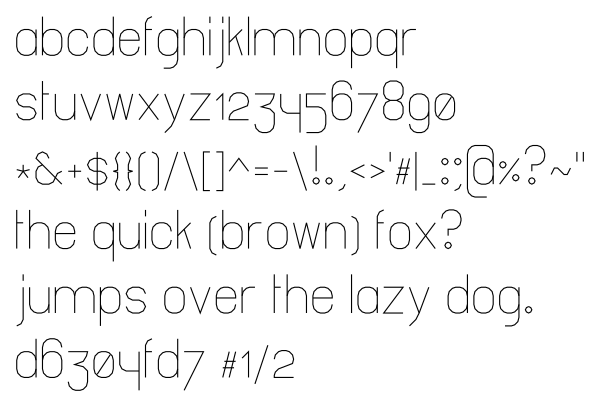grid-based system for designing simple symbols and fonts. including an example font. Mainly intended for plotter drawings.
The symbol descriptions look like this:
S4,9:DS6|S3DtRqS2eLp
You can use spaces to separate moves, so you can for instance write it like this:
S4,9: DS6| S3 DtRq S2 eLp
The first section (left of :) is the info section. Which currently contains
the size of the grid (as integers). Here the width is 4 and the height is
9. That is, there are 4 and 9 grid points in the two directions. That
means the width of the symbol will be 3 and 8.
In time this section might contain other things. Such as a translate command. (this might be useful if you are only drawing within a certain section of the grid.)
The next section is one or more paths, separated by the pipe symbol |.
Specifically, the above example should result in the two paths of the letter
b:
| <-- p1
|
|/-\ <-- p2
| |
| |
|\-/
Here are a few examples of more complex symbol definitions:
asterisk: S3,9:M1,3DS|S3.75Dq1,0.25t1,0.25|M0.25,5Dt0.75,1q0.75,1
w: S5,9:S2D q1,4 t1,4 q1,4 t1,4
y: S4,9:S2Dq1.5,4|M3,2De1.5,4e0.5,1e
When drawing a new path the cursor is always reset to the origin, which is in
the upper left corner. The coordinate system is rotated like this:
-
|
- --o-- x+
|
y+
From there you can perform relative and absolute moves. Once the command D is
entered the path will start being drawn. Which means you can move the cursor
into position before starting each path.
The following commands are allowed:
p N t
\ | /
L - o - R <-- o is the current position of the cursor
/ | \
e S q
Any number (see below) after a direction command is interpreted as the length
of the step, otherwise the step size is 1. You can also use two numbers
separated by a comma. For instance q2.5,3 will move the cursor two and a half
steps to the right, and three steps down. Similarly p2,1/2 will move the
cursor two steps left, and half a step up.
Accepted numbers are either integers: 1, fractions: 1/2 or decimals: 3.5.
Note that all decimals are converted to fractions. Decimals are a convenience
that allows you to write 4.5 instead of 9/2. However, you are better of
using 13/3 instead of 4.33.... The latter will most likely not add up
inside the limits of the grid. You can also use multiple commands in the same
direction, if you find that easier. For instance R4 R1/2.
That means that if you get out of bounds errors, it is either because you are using a decimal that does not "add up" properly inside the grid. Or simply because the resulting number is outside the grid.
Numbers are converted to float before being exported to json or svg
The following absolute moves are allowed
Mx,yto move to positionx,yrelative to theorigin.Zmove to the first position of the drawn path. (defaults toorigin)Wto move to move out to the right hand side of the drawing.wto move to the left side of the drawing.Hto move to the top of the drawing.hto move to the bottom of the drawing.
You can provide substitution groups in the groups property of the json
specification. Groups names should always start with a ( and end with a ).
Any (group) in a path definition will be replaced verbatim until there are no
more ( or ) left in the path specification. (Note: this means you can cause
infinite loops as well as memory leaks.)
The font paths are included in dat/*/res.json, along with SVGs for each
symbol. The raw descriptions are in dat/*.json.
At the moment the included fonts are:
original: blocky letterssmooth: smoother version.
In order to use this library
python3 setup.py install --user
You can then use the library from your code. see gridfont/__init__.py or
gridfont/writer.py to get an idea. More documentation might be added
later, if this seems useful to people.
To see other options use:
gridfont --help
To parse a symbol .json file such as dat/font.json run the following, to
output the results to the directory out
gridfont parse font.json out [--svg]
If you include the --svg flag, an svg will also be created for each symbol.
When you have a parsed symbol file (such dat/original/res.json), you can
write SVGs with it like this:
gridfont write res.json tmp.svg 'my text'
This is a project I started because I wanted a simple "font" that would allow me to easily draw line-based glyphs while plotting. I don't know whether I will end up developing this much further, but I'm open to suggestions.
- Improve smooth numerals
2and3? - Capital letters, at least
A-Z - shift origin (in info section)?
- simple pair kerning instructions?
- some ligatures?
-
This is very similar to the Hershey fonts: https://en.wikipedia.org/wiki/Hershey_fonts. Which you probably should use, as they have been around for some time
-
This method is also similar to drawing in Logo: https://en.wikipedia.org/wiki/Logo_(programming_language)
-
The path definitions are also similar to the SVG format (but simpler): https://en.wikipedia.org/wiki/Scalable_Vector_Graphics
-
If you find this interesting, you might also like Recursive Radical Packing Language: https://github.com/LingDong-/rrpl
-
Metafont (LaTeX): https://en.wikipedia.org/wiki/Metafont
-
LeonSans: https://github.com/cmiscm/leonsans

